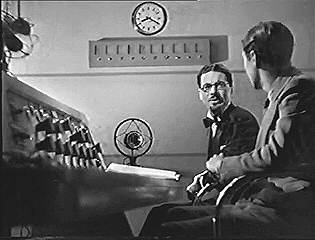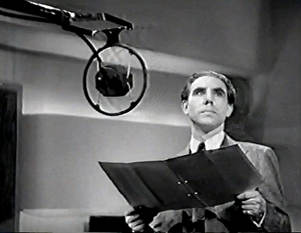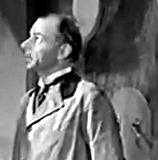

 Not
a real death, fortunately, but the title of a novel set in what
was
then the mysterious world of radio. It was written in 1934 by Val Gielgud
- brother of John Gielgud and then the BBC's Head of Productions
- and
'Holt Marvell' - actually Eric
Maschwitz, a lyricist and
writer for films and the BBC.
Not
a real death, fortunately, but the title of a novel set in what
was
then the mysterious world of radio. It was written in 1934 by Val Gielgud
- brother of John Gielgud and then the BBC's Head of Productions
- and
'Holt Marvell' - actually Eric
Maschwitz, a lyricist and
writer for films and the BBC.The plot revolves round a live broadcast of a play, using multiple studios (as was common at the time). One actor has a scene by himself, at the end of which the script calls for him to be strangled: he plays this alone in a separate studio, but at the end of the play is discovered to have been strangled in reality. The book goes through all the usual procedures of a detective novel, tracking the motives and opportunities of the suspects. (I won't give the solution away.) The book isn't at all badly written, though perhaps a little plodding in places, but is of particular interest because the authors have been careful to keep it realistic: the exact layout of Broadcasting House is made use of (floor plans are provided) and the technique of radio drama is accurately represented: it does provide an intriguing glimpse into the workings of the BBC.
 The same year it was made into
a film,
directed by Reginald Denham,
with Ian Hunter (best known as King Richard I in the 1938 Adventures of Robin Hood)
as the detective, Donald Wolfit as the murder victim, and Val
Gielgud
himself as the drama producer, Julian Caird (left). The film
sticks
closely to the plot of the book, but is lighter in tone, and
capitalizes on the glamour of broadcasting by including a number
of
cameo appearances by radio stars, among them Hannen Swaffer,
Gilllie
Potter, Elisabeth Welch and Percival Mackey. The film is
available on DVD and turns up occasionally on
television.
The same year it was made into
a film,
directed by Reginald Denham,
with Ian Hunter (best known as King Richard I in the 1938 Adventures of Robin Hood)
as the detective, Donald Wolfit as the murder victim, and Val
Gielgud
himself as the drama producer, Julian Caird (left). The film
sticks
closely to the plot of the book, but is lighter in tone, and
capitalizes on the glamour of broadcasting by including a number
of
cameo appearances by radio stars, among them Hannen Swaffer,
Gilllie
Potter, Elisabeth Welch and Percival Mackey. The film is
available on DVD and turns up occasionally on
television.Again, the feeling of period broadcasting is reasonably authentic: but when it was shown on television many years ago a well-respected technical journalist was trapped into recommending readers to watch it because it provides a 'fascinating glimpse into Broadcasting House in the 193os'. Of course it does nothing of the sort. Quite apart from the technical difficulties in filming in relatively small studios (the camera wouldn't have been able to get far enough back) the BBC would hardly have welcomed a large film crew underfoot for the month it took to shoot.
 All
the interiors were created at a small film studio in Wembley.
Though
the general atmosphere of the sets is correct, there are many
small
details which are wrong (if you want to be picky). The Variety
Studio
has a stage with tabs, as in reality (though the look is
slightly
different) but has stacking chairs instead of cinema-type tip-up
seats.
All
the interiors were created at a small film studio in Wembley.
Though
the general atmosphere of the sets is correct, there are many
small
details which are wrong (if you want to be picky). The Variety
Studio
has a stage with tabs, as in reality (though the look is
slightly
different) but has stacking chairs instead of cinema-type tip-up
seats.
 The
mock-up of the Dramatic Control Panel is very close to the real
thing,
but the drama microphones are slung on booms and placed above
the
actors, film-studio style (I would have expected drama studios
to use
stands, as now), as in the photo (right, of Donald Wolfit about
to be
strangled). Also, and quite wrongly, the studio doors have
catches on
them (visible behind the studio attendant, left).
The
mock-up of the Dramatic Control Panel is very close to the real
thing,
but the drama microphones are slung on booms and placed above
the
actors, film-studio style (I would have expected drama studios
to use
stands, as now), as in the photo (right, of Donald Wolfit about
to be
strangled). Also, and quite wrongly, the studio doors have
catches on
them (visible behind the studio attendant, left).The plot makes play of the fact that the drama was recorded on the Blattnerphone, but unfortunately they weren't able to show it - either it was technically impracticable, or perhaps the BBC wouldn't co-operate.
The most dramatic difference caused a lot of amusement among Control Room staff at the time. When the murderer is revealed there is a chase through Broadcasting House, including the Control Room on the eighth floor. In the book, the murderer makes his way onto the roof, is shot after himself shooting at a policeman, and falls 'a hundred and twelve feet sheer to the pavement below'.
In the film he rushes into a small room off Control Room, and evidently flings himself across some terminals as there is a flash, all the lights go out, and he is dead by electrocution.
This was the 50 volt relay supply.
